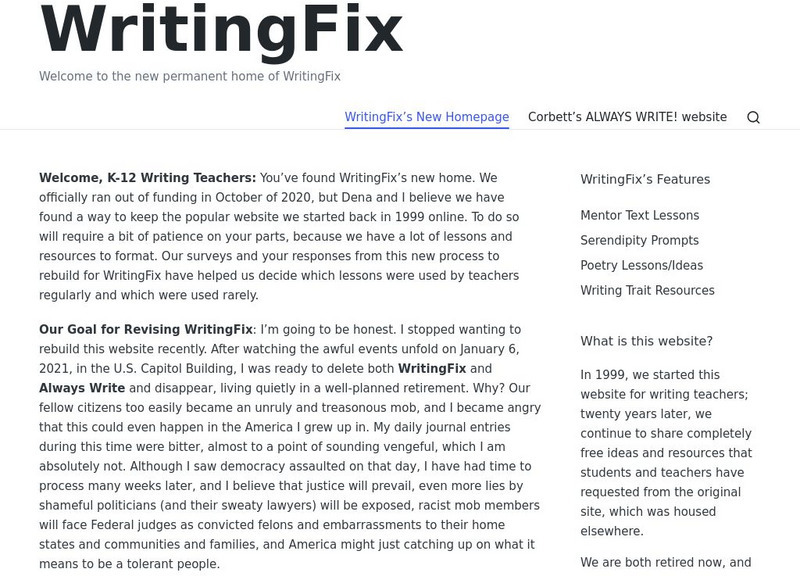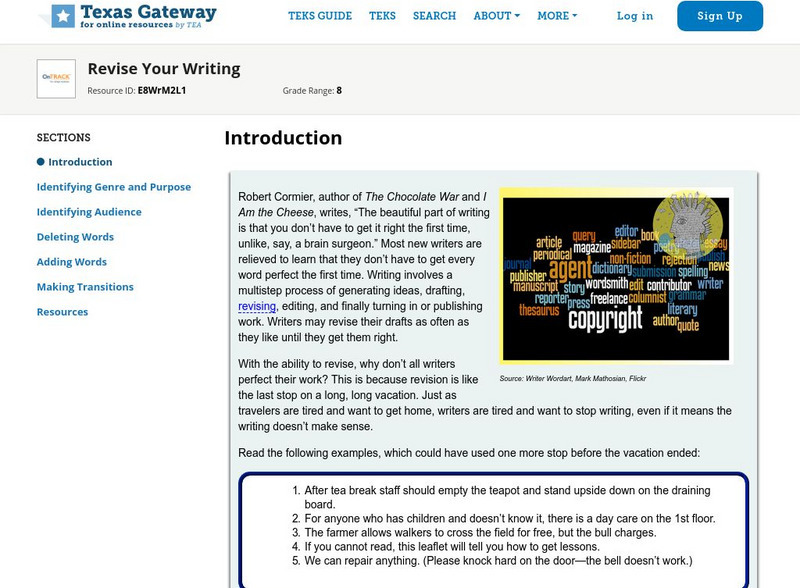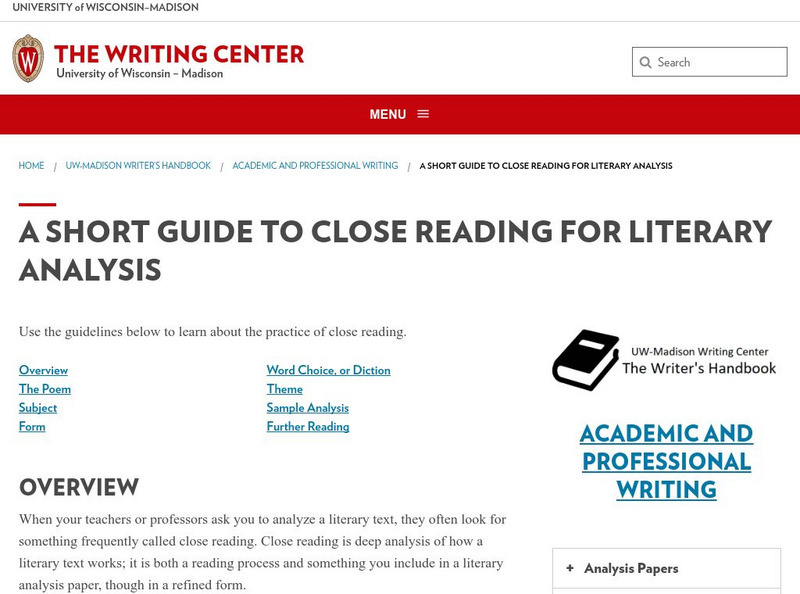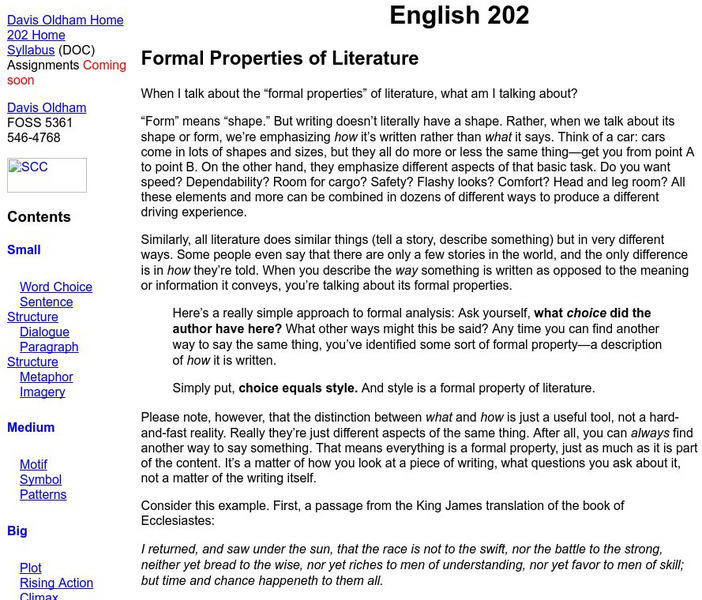Curated OER
Complete the Sentences 3
In this language arts worksheet, students read and analyze 20 incomplete sentences. Students complete the sentences by choosing one of 4 possible choices provided. This is from the UK.
Curated OER
Said Is Dead
Students revise writing to improve organization and word choice. They check for logic, order of ideas and precision of vocabulary. Students list different verbs for the word "said." They write dialogue in which the speakers tell a story...
Curated OER
Teaching of Writing Amy K
Learners examine strong verbs and select them while exploring expressive language. In this expressive language lesson plan, students use verbs that convey appropriate meaning. Learners discover sentence fluency using verbs in their...
Curated OER
Don't Say "Said," Say . . .
In this word choice worksheet, students read the various alternatives for the word 'said.' Students then brainstorm alternatives for another over-used word.
Curated OER
Writing a Comparison/Contrast Paragraph: Using Vivid Verbs
In this vivid verbs worksheet, students complete three activities that help them use strong, vivid verbs in the comparison and contrast writing.
Curated OER
Phrasal Verbs with Turn
For this language arts worksheet, students read 5 sentences; all have the phrasal verb "turn." Students choose the correct preposition to complete the sentence. Example: John turned --- to be a good student (out). This is intended for...
Curated OER
Complete the Sentences 4
In this language arts worksheet, students examine 20 incomplete sentences with 4 possible choices for endings. Students choose the most appropriate word to best compete the sentence.
Writing Fix
Writing Fix: Showing Creative Problem Solving
After reading excerpts in which Buck solves a problem in Jack London's The Call of the Wild, students write their own three-paragraph animal stories imitating London's style and word choice. Teacher and student instructions are provided...
Utah Education Network
Uen: I'm So Bright! I Wear My Shades Indoors!
This lesson engages students in learning about light through multiple sources. Students will learn how light is produced, reflected, refracted, and separated. Students will communicate their findings through an independent project that...
Texas Education Agency
Texas Gateway: Revise Your Writing
[Accessible by TX Educators. Free Registration/Login Required] In this lesson, you will learn to revise your writing for clarity. You will begin by reviewing some major considerations for revision: genre, purpose, and audience. You will...
University of Wisconsin
Univ. Of Wisconsin: Writing Center: Guide to Close Reading for Literary Analysis
This guide discusses how to approach analysis of a literary text, with the main focus being on the poem "Design" by Robert Frost. It explains how to examine the subject, the form, word choice or diction, and the theme. In each section,...
Writing Fix
Writing Fix: Unique Metaphor Collections
In this lesson plan, the first chapter of the novel Girl with a Pearl Earring is used as a mentor text. Students will identify metaphors and then create their own unique metaphorical descriptions that they will begin to collect in their...
Other
Shoreline Community College: Formal Properties of Literature
As students become more aware of text complexity, an understanding of the formal properties of literature becomes more important. This is an excellent examination of the kinds of choices writers make that change the way readers receive...
TES Global
Blendspace: Connotation/denotation
Work through links to activities, assessments, websites, and videos to learn about connotation and denotation.
PBS
Pbs Learning Media: Literary Elements and Techniques: Tone and Mood
Explore the difference between tone and mood in this animated video [2:28] from WNET through definitions and examples from poetry and prose. Discussion questions below help students to further apply their understanding before analyzing a...
English Worksheets Land
English Worksheets Land: 4 Shades of Verbs [Pdf]
Students learn about the differences among action verbs with similar meanings by placing them in order on a graphic organizer.
English Worksheets Land
English Worksheets Land: Plain Words and Fancy Words [Pdf]
Students learn about the differences between words with similar meanings by placing them in the right column of a graphic organizer.
English Worksheets Land
English Worksheets Land: Extreme Verbs Worksheet [Pdf]
Students learn about the differences among action verbs with similar meanings by placing them in order on a graphic organizer from weakest to strongest.
English Worksheets Land
English Worksheets Land: Sorting Through Horrifying and Size Adjectives [Pdf]
Students learn about the differences among adjectives with similar meanings by placing them in order from least to most on a graphic organizer.
English Worksheets Land
English Worksheets Land: Sorting Through Horrifying and Size Adjectives [Pdf]
Students learn about the differences among words with similar meanings by cutting them out and pasting them in order from most to least on a graphic organizer.
English Worksheets Land
English Worksheets Land: 4 Shades of Verbs 2 [Pdf]
Students learn about the differences among verbs with similar meanings by placing them in order from least to most on a graphic organizer.
















